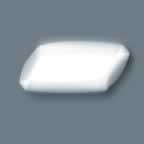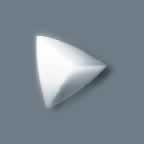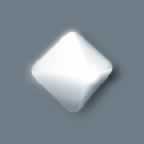 |
 |
|
A
number of factors enter into the performance of a diamond
wheel dresser. Each is important, but particularly with
single and multiple point tools, there's nothing more
important than the diamond itself. They are the hardest
naturally occurring substance. While diamonds consist
of pure carbon, their shape and quality can vary enormously,
and each variant has it's own effect on tool performance
and economy. |
Quality:
Among
naturally formed diamonds, all but the most expensive,
gem quality stones will have flaws. These can be evidenced
as slight discolorations, which only rarely affect the
performance of the diamond, or they can be seen as cracks
and fissures. Whether located near the stone's surface
or deep in its core, even the slightest cracks can cause
poor performance and premature failure.
Shape:
Diamonds
come in a variety of shapes, and provide from one to six
usable points. A usable point is one with sufficient height
and sharpness for proper performance that will not fracture
during operation. With six such points, the stone can
be rotated up to five times, each time exposing a new
point.
Stones
with a higher number of usable points have a higher initial
cost. With proper use and periodic point rotation, however,
the higher initial cost is rewarded with longer tool life
and eventually
greater economy. |
Diamond
Dressing Tool Stones Normal
Size and Tolerance |
|
Carat |
Decimal |
Tolerance |
|
1/5 |
.20 |
(.17
~ .23) |
|
1/4 |
.25 |
(.21
~ .29) |
|
1/3 |
.33 |
(.29
~ .39) |
|
1/2 |
.50 |
(.40
~ .62) |
|
3/4 |
.75 |
(.63
~ .87) |
|
1 |
1.00 |
(.88
~ 1.14) |
|
1
1/4 |
1.25 |
(1.15
~ 1.34) |
|
1
1/2 |
1.50 |
(1.35
~ 1.74) |
|
2 |
2.00 |
(1.75
~ 2.25) |
|
|
 |
 |
 |
 |
 |
|
Crystal |
Dodecahedron |
Elongated |
Maacle |
Octahedron |
| Shape
and Quality Classification |
|
Grade |
Description |
|
#2
Gem |
Sound,
smooth dodecahedrons with no detrimental cracks
or flaws |
|
#3
Ultra |
Sound
stones, predominately octahedral, with no major
cracks or flaws |
|
#4
Premium |
Sound,
semi-blocky and octahedral stones with smooth, frosted
or slightly irregular surfaces, having 3 or more
points and no major cracks or flaws |
|
#5
AAA |
Semi-blocky,
octahedron and dodecahedron stones with at least
3 usable points |
|
#5
AA |
Semi-blocky
and irregular shapes with 1 or 2 good points |
|
#5
A |
Irregular
shaped stones with 1 good point |
|
#6
B (Tool room) |
Possibly
resettable stone, rough surface, with 1 good point |
|
#7
TA (Throw away) |
Disposable
non-resettable stone |
| How
to Determine Diamond Size |
|
Wheel
Diameter |
Wheel
Width |
Recommended
Size in Carat |
Hardness:
Although
all diamonds are chemically identical, differences
in hardness do occur. Stones mined in Africa, for
example, tend to be hardest. These are followed
closely by stones from Russia, Australia and Brazil.
In terms of color, white or yellow diamonds tend
to be the hardest. |
|
100 |
12 |
0.25 |
|
150 |
12 |
0.30 |
|
175 |
12 |
0.50 |
|
250 |
40 |
0.75 |
|
350 |
30 |
1.00 |
|
400 |
30 |
1.25 |
Size:
Larger
diamonds are needed for larger wheels. As a rule
of thumb, we recommend selecting the largest diamond
your budget can afford; and as a minimum, at least
a half carat for every inch of wheel face. Other
factors influence the selection of a diamond's size.
These include:
◊
Wheel diameter
◊ Rrigidity of
the machine or dressing device
◊ Use of coolants
◊ Grain coarseness
◊ Bond hardness
◊ Dressing wheel
speeds
Larger
stones offer several advantages. First, with more
of the stone contacting the wheel, the dressing
operation is completed faster. Second, with greater
surface area, heat is dissipated more rapidly. Third,
larger stones are studier, and can withstand more
abusive conditions. And finally, they last longer. |
|
450 |
50 |
1.75 |
|
600 |
50 |
2.00 |
|
600 |
75 |
2.50 |
|
750 |
75 |
3.00 |
|
750 |
100 |
3.50 |
|
A diamond
should be large enough such that it's surface
area is sufficient to give all detrimental heat
to its surrounding holder. Any built-up heat may
lead to the destruction of the diamond. Diamond
size is given in carat (1 carat=0.2g).
|
|
|
|

